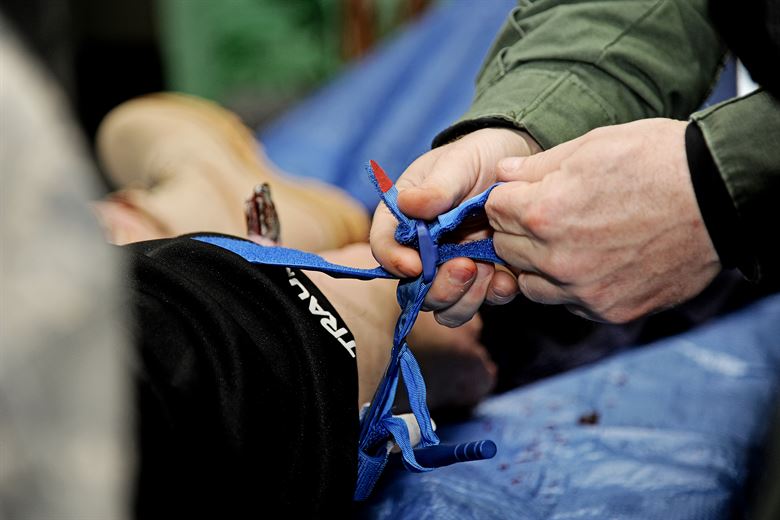Mass casualty incidents (MCIs) such as shootings, infrastructure collapses, or bombings can quickly overwhelm emergency medical resources with gravely injured victims. This has highlighted the importance of training the public in basic medicine so that bystanders can provide support. When discussing bystander emergency medicine, initiatives promoting the spread of cardiopulmonary resuscitation (CPR) knowledge spring to mind first. A myriad of studies have demonstrated improvement in both survival and outcomes when CPR-trained individuals reach patients in cardiac arrest before emergency medical service (EMS) units. However, a new trend in civilian emergency medicine is on the rise: bleeding control. Serious arterial bleeding from traumatic events can cause an individual to bleed to death in five minutes or less [1]. How often is five minutes enough time for EMS to mobilize and treat a potentially fatal hemorrhagic event?
The value of bleeding control has long been acknowledged, but the national attitude on tourniquets has changed drastically over the last decade. Easy-to-use commercial tourniquets were designed in the early 2000s to stop arterial bleeding in any appendage. For years, their primary role in ambulances was to gather dust in drawers for fear of long-term nerve damage following their application. As a result, less drastic bleeding control measures were advocated. Only in the last several years have EMS courses taught that tourniquets are safe and useful devices. This instructional change is mainly due to extensive research on tourniquet use during American wars in the Middle East, where their life-saving capabilities were characterized and publicized [2].
A harsh reality of the United States today is that MCIs occur all too frequently, especially mass shootings. The 2012 Sandy Hook school shooting in Connecticut catalyzed the development of the Hartford Consensus through the American College of Surgeons (ACS). A major tenant of the Consensus is that bleeding control should be recognized and performed rapidly, with either tourniquets or improvised devices [3]. Bystander involvement in emergency bleeding control was a key point of emphasis in the report, which cited the obvious but rarely considered issue of EMS response times and resources. The value of this report was bolstered by the then-recent Boston Marathon bombing in 2013, where most victims were helped by civilians long before EMS units arrived [4].
Establishing a need for bystanders to be knowledgeable in bleeding control highlighted the potential for significant improvement in education. It is relatively easy to find a CPR class on a Saturday at the Red Cross, but finding high-quality bleeding control courses can be difficult. The ACS presented the Hartford Consensus to the White House in 2015, which led to the development of the nationwide “Stop the Bleed” initiative sponsored by the Department of Homeland Security. This movement relies on dedicated community members to obtain training and resources to teach in-person classes. More than 125,000 Americans have received bleeding control training as a result, making this a truly impressive movement [5].
Some research on bystander tourniquet use is skeptical, citing low incidence and efficacy of use in EMS. A three-year survey of EMS calls nationwide found that 0.2 in 1000 injury-related EMS incidents involved the application of a tourniquet [6]. Another study covering seven years in urban Boston found similarly low incidence and noted that the short response times and hospital transport times relegated tourniquet use to “last resort” status [7]. However, ask anyone passionate about bleeding control and they will cite the worst-case scenarios. “As trauma goes, it’s far more common that it’s car accidents we’re dealing with… and tourniquets really have a use in these particular scenarios”, Dr. Andrew Tang of Banner University Medical Center – Tucson reflected [8]. Any injury involving an amputation or arterial bleed can lead to exsanguination well before the arrival of EMS, so anyone nearby with the appropriate training can save a life. The Bleeding Control course (“B-Con”) from “Stop the Bleed” even advocates for individuals to be their own savior if necessary. Some instructors teach students how to tighten a tourniquet on their own “amputated arm” using their non-injured arm and teeth, with the implication being that one should always carry a tourniquet.
While it will be a long time before tourniquets are distributed as widely as AEDs and general first aid kits, bleeding control advocates are hoping this will soon become a reality. Homeland Security grants are already increasing the number of military bases and public institutions with bleeding control kits positioned next to AEDs. It will take more state and local efforts to continue this progress as there is currently no coherent national policy or guideline for bleeding control [9]. In fact, the Arizona Department of Health Services does not require Basic Life Support ambulances (crews with only EMTs and no paramedics) to carry tourniquets, leaving the decision to carry life-saving equipment up to the discretion of counties or private ambulance companies [10]. The trend towards increasing the availability of bleeding control equipment and training will likely gain even more traction. Last year’s Route 91 Harvest festival shooting in Las Vegas was characteristic of most MCIs. Namely, the sheer volume of victims bleeding profusely required bystanders to make up for the intrinsic inability of EMS resources to activate quickly enough. Las Vegas surgeon Dr. Deborah A. Kuhls noted that “some of [the] patients were saved by bystanders,” referencing a case where a belt was used as a makeshift tourniquet [11]. A recent survey found that more than 90% of Americans would be willing to help a stranger who is bleeding [12], an optimistic sign that initiatives like “Stop the Bleed” will only continue to grow.
- Holland K. How long does it take? Healthline. https://www.healthline.com/health/bleeding-to-death. Published April 11, 2018.
- Hawk AJ. How hemorrhage control became common sense. J Trauma Acute Care Surg. 2018;85(1S Suppl 2):S13-S17. doi:10.1097/TA.0000000000001862.
- Jacobs LM. The Hartford Consensus III: Implementation of Bleeding Control. Bulletin of the American College of Surgeons. http://bulletin.facs.org/2015/07/the-hartford-consensus-iii-implementation-of-bleeding-control/. Published July 1, 2015.
- White E, Cash C, Augustine JJ, and Fowler RL. Tourniquets in Field Management of Active Bleeding. Journal of Emergency Medical Services. https://www.jems.com/articles/print/volume-41/issue-40/special-focus-gearing-up-for-active-shooter-tactical-high-threat-incidents/tourniquets-in-field-management-of-active-bleeding.html. Published April 6, 2016.
- Stop the Bleed: 2018 Progress Report. BleedingControl. https://www.bleedingcontrol.org/~/media/bleedingcontrol/files/2018_stb_progressreport.ashx. Accessed August 23, 2018.
- El Sayed MJ, Tamim H, Mailhac A, Mann NC. Trends and Predictors of Limb Tourniquet Use by Civilian Emergency Medical Services in the United States. Prehospital Emerg Care. 2017;21(1):54-62, doi:10.1080/10903127.2016.1227002.
- Kue RC, Temin ES, Weiner SG, et al. Tourniquet Use in a Civilian Emergency Medical Services Setting: A Descriptive Analysis of the Boston EMS Experience. Prehospital Emerg Care. 2015;19(3):399-404. doi:10.3109/10903127.2014.995842.
- Tricoles, R. Tourniquet Makes a Comback as Lifesaver. UA News. https://uanews.arizona.edu/story/tourniquet-makes-comeback-lifesaver. Published July 10, 2017.
- Ramly E, Runyan G, King DR. The state of the union: Nationwide absence of uniform guidelines for the prehospital use of tourniquets to control extremity exsanguination. J Trauma Acute Care Surg. 2016;80(5):787-791. doi:10.1097/TA.0000000000000988.
- Bureau of EMS & Trauma System Statues and Rules. Arizona DHS. https://www.azdhs.gov/documents/preparedness/emergency-medical-services-trauma-system/statutes-rule-book.pdf. Accessed August 23, 2018.
- Fink, S. After the Las Vegas Shooting, Concertgoers Became Medics. The New York Times. https://www.nytimes.com/2017/10/15/us/las-vegas-shooting-civilian-first-aid.html. Published October 15, 2017.
- Fisher AD, Bulger EM, Gestring ML. Stop the Bleeding: Educating the Public. JAMA. 2018;320(6):589-590. doi:10.1001/jama.2018.7301.
Luke Wohlford is a medical student in the University of Arizona College of Medicine - Phoenix, Class of 2022. He graduated from the University of Arizona in 2018 with a Bachelor of Science in physiology. Luke plans to go into emergency medicine has special interests in public health and EMS. He spends most of his free time hanging out with his dogs Kanye and Kelso or feeling guilty about not exercising.


